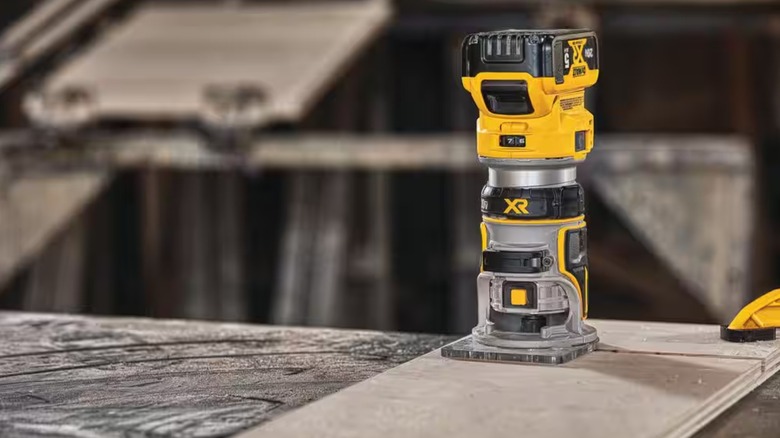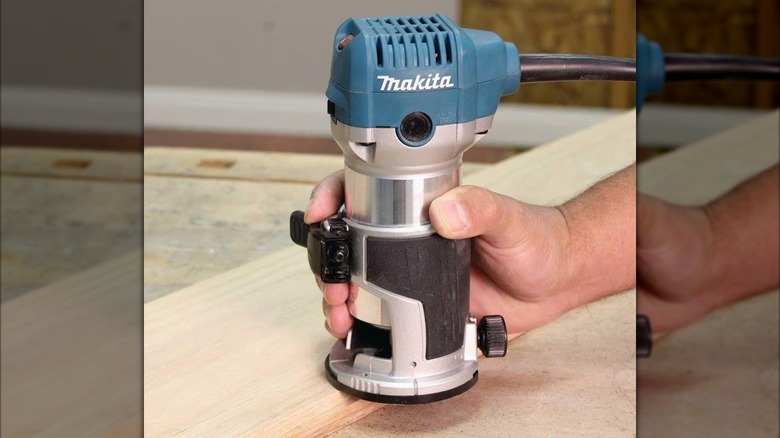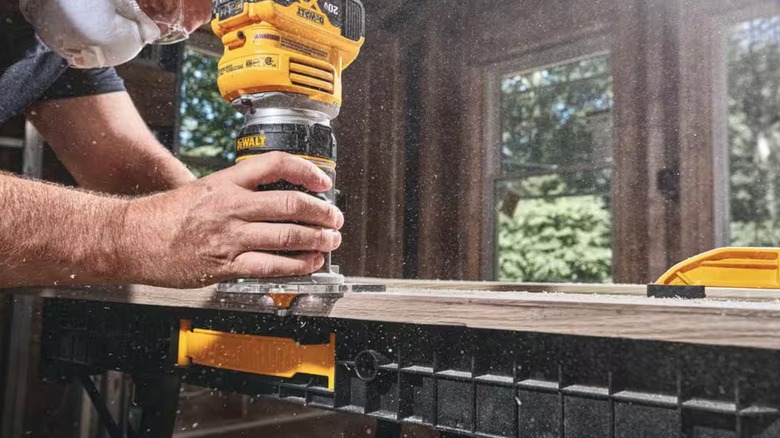What Is A Trim Router And How Do You Use It For Your Woodworking Projects?
We may receive a commission on purchases made from links.
Woodworking isn't just about throwing giant saws around and rubbing power sanders on everything; sometimes you need a particular tool for the delicate, precision work. When you're looking to work the details on your latest wooden project, a router is a good choice, providing precision cutting and grinding performance via a small, yet powerful spinning bit. However, a full-sized plunge router can be a bit excessive for smaller woodworking projects, not to mention potentially difficult to use without both hands.
If you need the precision power of a router in a lighter, more compact package, that's where the trim router really shines. Trim routers, also known as palm routers or compact routers, operate on the same basic principle as other routers, powering a spinning bit with an onboard motor. The difference is that their tube-shaped bodies are small and light enough to operate with one hand, giving you extra freedom and dexterity perfect for minute tasks like profiling edges and trimming excess material.
A trim router is a compact router you can operate with one hand
A trim router is a relatively small woodworking tool, powered either by an electrical outlet or a rechargeable battery pack. The Makita Fixed Base compact router, for example, uses a long electrical cord to power its 1.25 horsepower motor, while the DeWalt 20V Max compact router uses one of the brand's 20V Max battery packs. Either way, these tools feature small, yet powerful onboard motors that spin up a rotating metal bit at the bottom at speeds ranging from 20,000 to 30,000 RPM. That bit is topped off by a solid, fixed base, allowing you to place the router right on top of whatever you're working on and press the bit against the wood. The bit can also be swapped out for bits of other shapes and sizes to fit your needs.
What's nice about a trim router, compared to the other wood router types like bulky plunge router or entire routing table, is that you can safely turn it on, hold it, and guide it with just one hand. Their cylindrical shapes make them fit cleanly in most hands, with power switches and/or speed dials positioned near where your thumb would be for easy access. Compared to a plunge router, a trim router may have a weaker motor with reduced output, but that just means you can use it for delicate, precision work without worrying about accidentally grinding off your project's entire front side.
Trim routers are great for edge profiling, flush trimming, and more
Compared to larger, more powerful woodworking tools like reciprocating saws or power sanders, which are intended more for large scale cutting and finishing, a trim router does its job on the detailed level. While it may not be an essential power tool for a woodworker, you might just be glad you had it.
For example, let's say you're trying to make a small wooden bin for yourself. Despite your best efforts to cut the wood into perfect boards for assembly, there's a strong possibility there will be some jagged, dirty edges and flecks hanging off the sides. This could interfere with assembly, not to mention make the bin unpleasant to touch and look at. This is where the trim router comes in; by placing the tool on top of the boards and running it along the sides, you can quickly shave off that excess material without severely altering the board's overall dimensions. Just like that, it's nice and smooth and ready for action.
Another good use for a trim router is edge rounding and profiling. If you're trying to add rounded edges to a project for safety or aesthetic purposes, a trim router pressed against them will file them down to your preferred thickness and shape. A trim router is much easier to use for this purpose than a large power sander, yet more powerful than something like a rotary tool.
If you're particularly skilled with your trim router, you can even operate it freehand rather than just sticking to the sides and edges of your project. You could press the bit into the top of the board to draw simple shapes or write names, just to give your project that extra bit of personalization.


